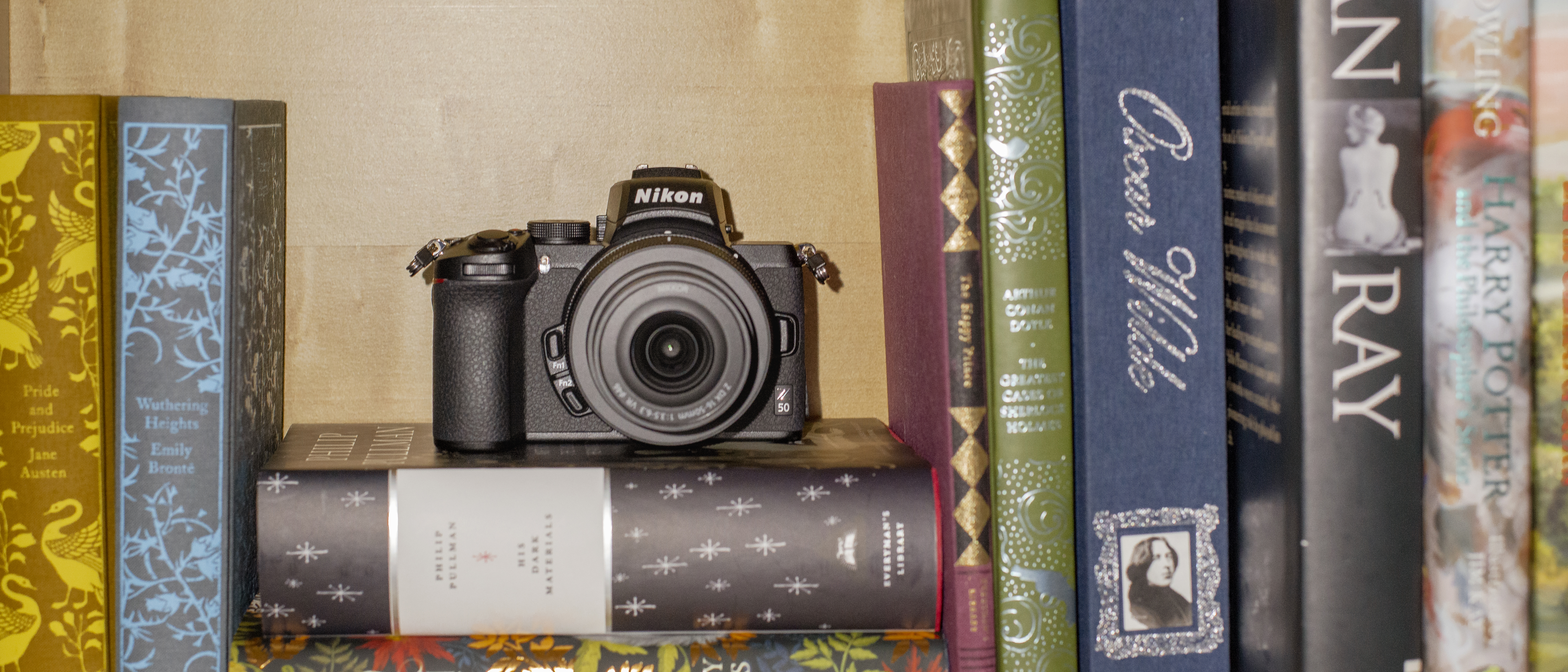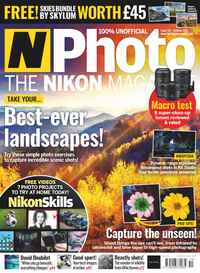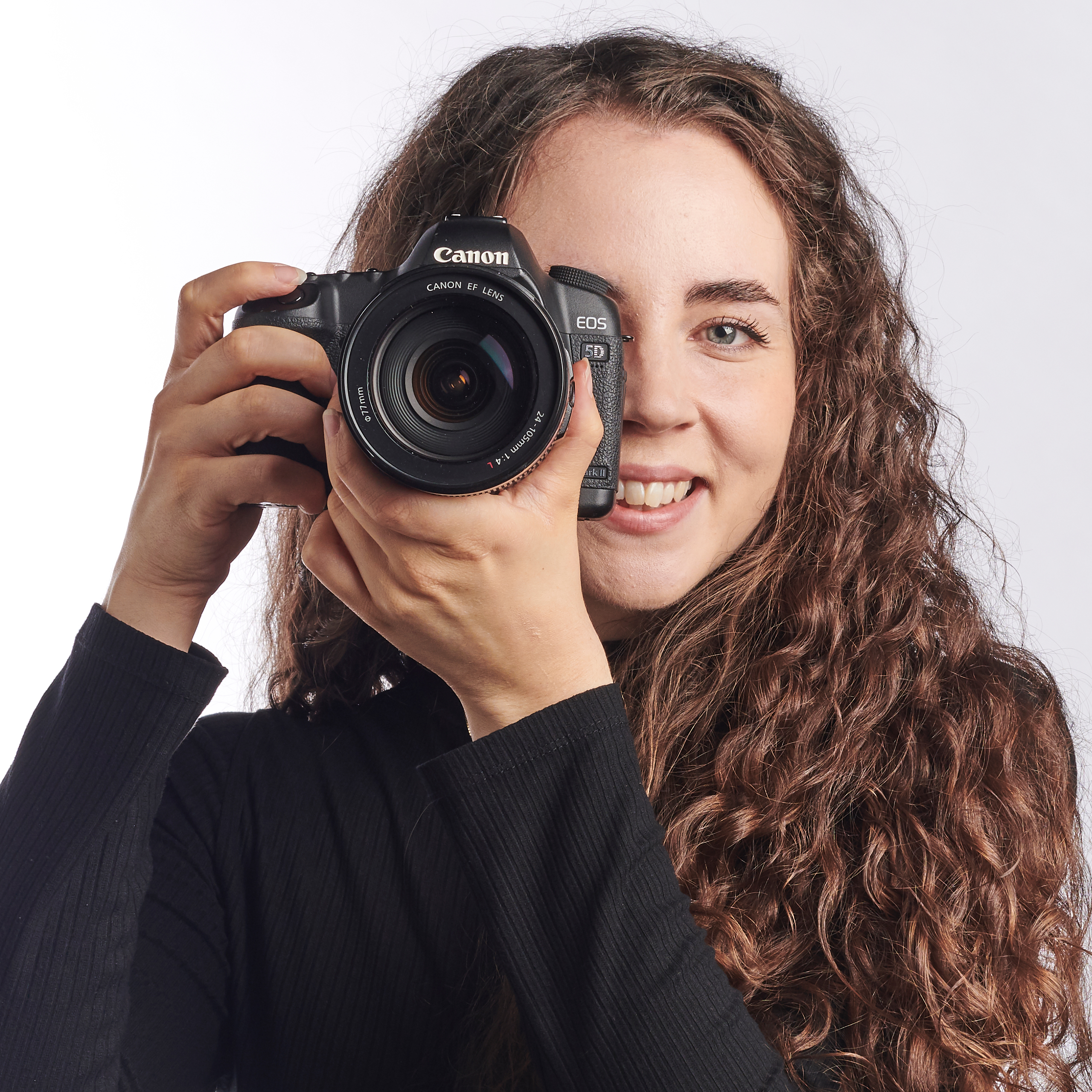Digital Camera World Verdict
The Nikon Z50 is not just a scaled down version of the Nikon Z6 and Z7. Nikon has done a remarkable job of giving such a small camera such a solid one-handed grip, but quite apart from the size of the camera, we were impressed by the 16-50mm pancake kit lens which is one of the slimmest APS-C kit lenses we've yet seen and uses a 'proper' mechanical zoom rather than an electrical power zoom system. But the clincher could be Nikon's pricing. Body only, the Z50 already costs less than its chief APS-C rivals, the Sony A6400 and Fujifilm X-T30, and the pricing for the kit lens and twin lens bundles is really quite remarkable.
Pros
- +
Compact size and handling
- +
4K video
- +
11fps continuous shooting
- +
Super-slim 'pancake' kit lens
Cons
- -
Single UHS I SD card slot
- -
300-shot battery life
- -
Awkward flip-under selfie screen
Why you can trust Digital Camera World
The Nikon Z50 (or Nikon Z 50 as Nikon prefers to write it) brings Nikon's mirrorless camera technology to the hobbyist market. Nikon's full frame mirrorless cameras might be tempting, but not everyone can afford them!
Nikon’s first stab at producing interchangeable lens mirrorless cameras didn’t exactly set the world on fire; the 1-series’ relatively small, low-resolution 1-inch CX sensor – with a 2.7x crop factor – quickly fell behind its mirrorless rivals.
The solution was the Z mount, which was introduced in late 2018 and so arrived somewhat late to the mirrorless party. But if you’re going to turn up late, you’re going to have to make quite an entrance – and the Nikon Z50 has certainly done that.
Update: Eight months after its release, the Nikon Z50 still only has the two native DX format Nikon Z lenses it was launched with. The new Nikon Z fc will be offered with a new, compact 28mm SE prime lens, but that's actually a full frame optic. The lack of DX lenses for the Z50 (and the Z fc) is starting to worry us.
• See also: Nikon Z50 vs D7500 | Nikon Z30 vs Nikon Z50 vs Nikon Z fc
With the revolutionary Z mount in Nikon mirrorless cameras, the company rethought its lens mount from the ground up. The first two models, the full-frame Nikon Z7 and Z6, really showcased this cutting-edge tech, with range of ‘S’-line lenses that are amongst the sharpest we’ve ever tested. This qualifies Nikon's Z cameras as amongst the best mirrorless cameras you can buy. But they come at a hefty price. Now, a shade over a year since the launch of the Z mount, Nikon brought out its first more affordable mirrorless Z-mount model, and it already looks like one of the best Nikon cameras for hobbyists and enthusiasts – or it would, if there were just a few more lenses to go with it.
Much of this cost saving is due to the Z50 using an APS-C ‘DX’-size sensor, as used in its range of DSLRs from enthusiast down to entry-level, and this has enabled the camera to launch with a price tag well under $1,000/£1,000. This DX body is fitted with the same Z mount used on the full frame models, so full-frame Z lenses can be mounted directly onto the Z50 (and the new Z DX lenses will fit the Z 6 and Z 7, automatically engaging crop shooting mode). Using the same FTZ adaptor, existing DX and FX lenses for DSLRs can be used on the Z50 too.
That's actually just as well, because even in the middle of 2021, months after its launch, there are only two 'native' DX lenses. If you want a super-wide-angle, for example, the only option right now is a Nikon DSLR lens and the FTZ adaptor – not ideal!

Specifications
Lens mount: Nikon Z
Camera Format: APS-C
Pixels: Effective 20.9 Megapixel
Maximum Resolution: 5568 x 3712
Aspect Ratio: 1:1, 3:2, 16:9
Sensor Type: CMOS
Sensor Size: 23.5 x 15.7mm
Image File Format: JPEG, RAW
Bit Depth: 14-Bit
Image Stabilization: Digital (Video Only)
ISO Sensitivity: Auto, 100 to 51,200 (Extended: 100 to 204,800)
Metering Method: Center-Weighted Average, Highlight Weighted, Matrix, Spot
Continuous Shooting: Up to 11fps
Recording Modes: UHD 4K (3840 x 2160) at 23.976p/25p/29.97p, Full HD (1920 x 1080) at 23.976p/25p/29.97p/50p/59.94p/100p/119.88p
Autofocus Points: 209 Phase Detection points
Memory Card Slot: Single slot SD/SDHC/SDXC (UHS-I)
Dimensions (W x H x D): 4.98 x 3.68 x 2.36" / 126.5 x 93.5 x 60 mm
Weight: 395g (Body Only)
Key features
The smaller physical sensor size isn’t the only place where savings have been made. This model doesn’t feature ‘in body image stabilization’ (IBIS), so the lenses that launch with the new model have Nikon’s Vibration Reduction built in.
But otherwise, the specs are truly impressive. The 20.9 MP DX-format sensor borrows the fast, wide Hybrid-AF (autofocus) system from Nikon's full-frame 'Z' cameras, with 209 AF points covering 90 percent of the sensor width and height. Its 11fps continuous shooting range (with full autofocus and auto exposure) almost matches the Z 6 (and exceeds the Z 7), and certainly puts it up amongst the fastest shooters around, matching many pro-level DSLRs. It’s a great low light performer too, with a native ISO range of ISO100-51,200 at up to -4EV.
And the Z50 is great for video, shooting 4K across the full sensor width, rather than a cropped version that some rivals have employed. 4K time-lapse sequences can be created in-camera, while shooting in Full HD adds additional slow-motion footage mode.
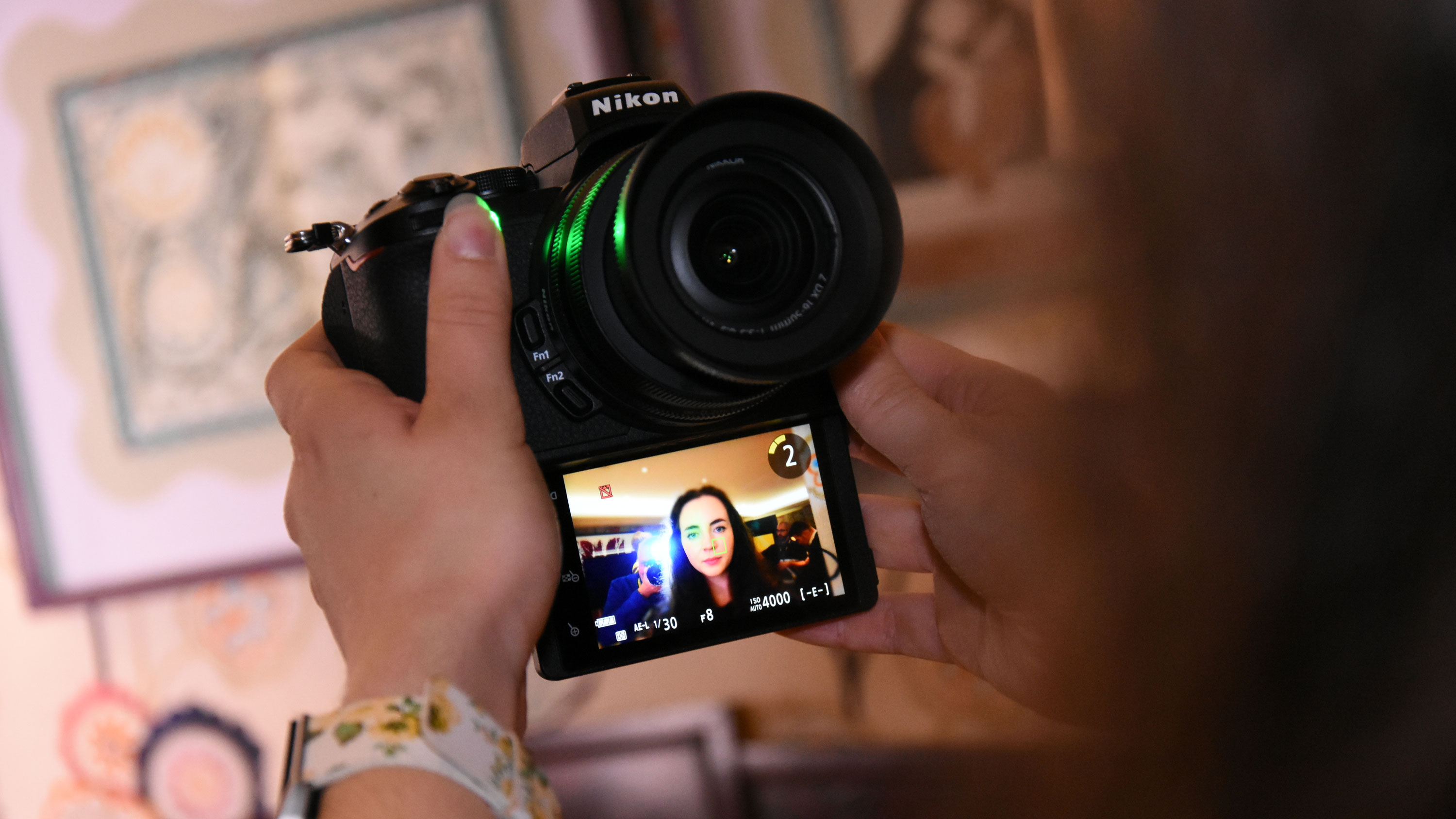
The Z50 also features an electronic viewfinder. It’s lower-resolution than its full-frame cousins at 2.36 million dots rather than 3.6 million, but we found it to be sharp and with few signs of the lag that have plagued some of Nikon’s competitors. Electronic viewfinders do take a little getting used to, but once you do, seeing the effect of your exposure settings through the viewfinder before you take the shot is nothing short of brilliant.
A tilting 1.04 million-dot touchscreen flips by 180 degrees to sit below the camera body, and is primarily designed for selfies and vlogging use; Nikon sees a large part of its target market to be ‘influencers’ who use platforms such as Instagram and Youtube to share content. This does mean that the screen would be obscured when used in this way if the camera were mounted on a tripod, but Nikon has hinted that a solution to this is in the works.
It's worth pointing out that Sony's brand new ZV-E10 vlogging camera does have a vari-angle screen, and is a good deal cheaper than the Z50. The Nikon does have a viewfinder and it's a much more rounded stills+video camera, but still.

Nikon Z50: Build and handling
We thought the Nikon Z6 and Z7 were compact, but the Z50 is positively dinky, particularly with the new ‘pancake’ Nikkor Z DX 16-50mm f/3.5-6.3 VR kit lens attached. There's also a new Nikkor Z DX 50-250mm f/4.5-6.3 VR telephoto zoom.
The camera may be physically smaller and lighter than full-frame Z models, but it uses a similar deep grip that is comfortable to hold. It has fewer buttons than the Z6 and Z7, but touch icons etched next to the touchscreen replace some of the functionality of the physical buttons. (We refer to the Nikon Z6 and Z7 throughout this review, but of course we also include the newer Nikon Z6 II and Nikon Z7 II.)
There are both rear and front-mounted scroll wheels that enable aperture and shutter speed to be quickly changed, among other functions. The exposure mode dial flips from the left to the right side of the top plate, compared to the Z6/7, but in a space-saving (and cost-saving) measure, there’s no top LCD. Two programmable ‘Fn’ buttons enable commonly used settings to be quickly changed, and are in the same place as the Z6/7, nestled close to the lens mount.

In all, it feels very much part of the existing ‘Z’ family, but even smaller. If the Nikon Z7 is the mirrorless equivalent of the D850 pro full-frame DSLR and the Z6 the D750 enthusiast full-frame model, then the Z50 is roughly on par with the Nikon D7500 (and perhaps the Nikon D500) as an enthusiast APS-C camera, and Nikon has hinted that we can further expect to see even lower-cost mirrorless entry level models released in the fullness of time to fit alongside the Nikon D5600 and D3500.
But then the Nikon Z50 doesn't just face competition from the Z6 II and Z7 II – there's also the Nikon Z5. It's cheaper than both, and while it's bigger and more expensive than the Z50, it's a huge margin, and the Z5 could tempt a lot of people with its ready-made full frame Nikkor Z lens range.
Nikon Z50: Performance
One of the biggest selling points of the Nikon Z50 is how light and compact it is, but you can't truly appreciate these qualities until you're actually shooting with it. We took the Nikon Z50 around Bath city centre on a busy Saturday afternoon, and it was a pleasure to shoot with. It easily slipped into a small messenger bag, which meant we didn't have to mess around with a proper camera bag for a casual trip out.
However, despite its diminutive and unassuming size, the Nikon Z50 is capable of much more than just travel and holiday snaps. The Z50 was perfectly suited to a run-and-gun shooting style as we captured quick snaps in the bustling city centre. With a small and non-threatening profile - plus the incredibly useful tilting touchscreen LCD - the Nikon Z50 is perfectly suited to street photography.

But photography isn't the Z50's only strong point. With the ability to capture uncropped 4K video, Nikon has positioned the Z50 as a strong contender for the attention of the rapidly growing, lucrative vlogger / influencer market. We tested out the Nikon Z50's video functionality and were pleased with the results, including the focus peaking feature, which works just as well as it does on the Nikon Z7.
One of the criticisms with the Z50 is that the LCD touchscreen tilts downwards, which prevents users from being able to mount the camera on a tripod as they vlog. However, if a vlogging camera's screen doesn't articulate out sideways, it's caught in a bit of a catch 22 between getting in the way of either a microphone (if it tilts upwards) or a tripod (if it tilts downwards).
While it would have been nice for the Z50's screen to articulate sideways (like the Panasonic Lumix GH5 II), the Nikon Z50 is so incredibly light that a gimbal or mini tripod grip isn't really essential. While high end professional vloggers might want to give this one a miss, we could see the Z50 proving very popular with influencers who aren't overly fussed about hyper-smooth footage.


Despite the fact that we were shooting in JPEG on an incredibly grey and overcast day, we were able to get plenty of detail out of the Nikon Z50's files without compromising image quality.
We also tried shooting indoors, using only (minimal) window light. The Z50 worked well here as well, with the tilting screen and 16-50mm kit lens working in perfect harmony to capture top-down shots.
Another thought that struck us as we were testing the Nikon Z50 was that other enthusiast-level mirrorless cameras are often beautifully designed, but can fall short when it comes to being used over long periods of time. A boxy design can be very pretty aesthetically, but not so useful when it comes to shooting. The ergonomic design of the Nikon Z50 was another aspect of the camera that could only be appreciated after an extended period of use. With the deep grip paired with the 16-50mm kit lens, the Z50 is perfectly balanced.

Nikon Z50: Lab tests
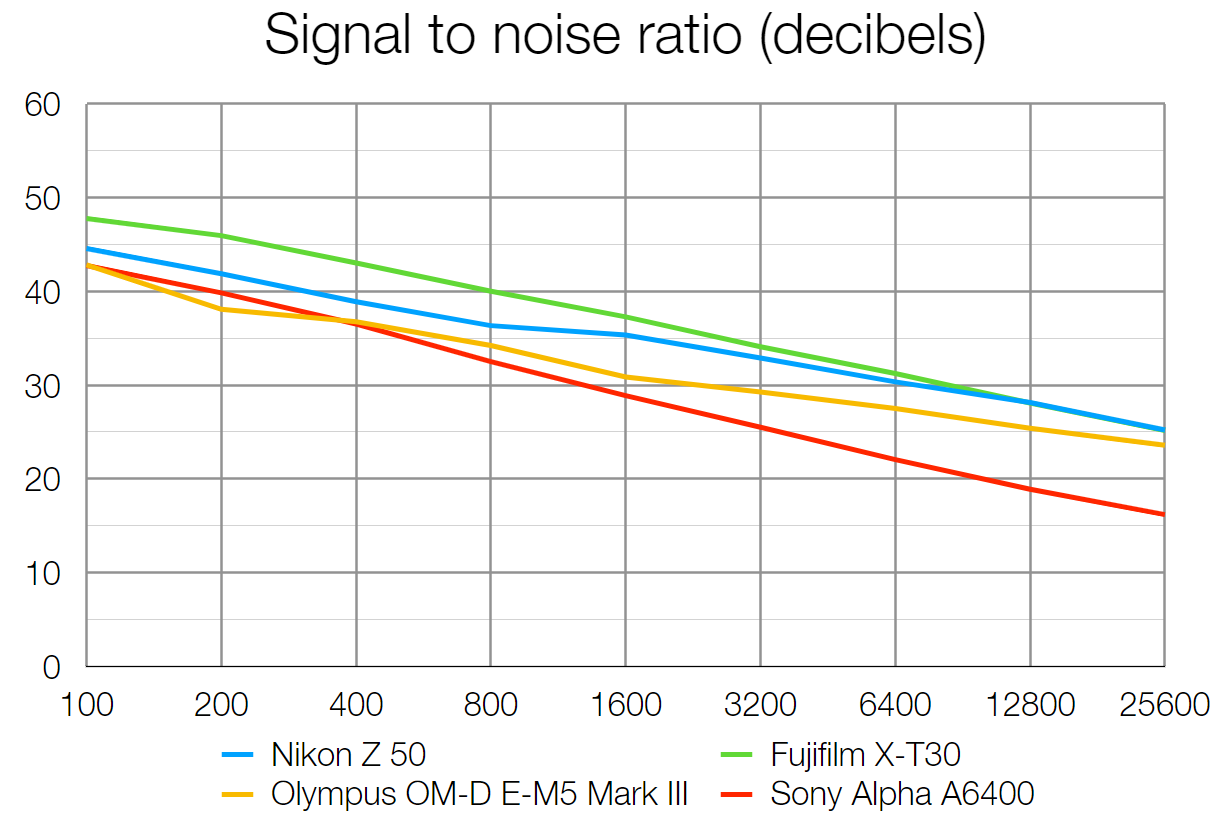
Our signal to noise test measures image clarity and the ratio of the actual image 'data' you want to capture, versus the image noise that you don't want, but will inevitably be visible when shooting at higher ISO sensitivities. The Z 50 manages to produce cleaner images than all but the Fujifilm X-T30. However, while it does statistically produce cleaner images at lower sensitivities, this will be near-impossible to see in real-world shots. What maters most is the Z 50 claws back ground at higher sensitivities, where image noise is more visible.
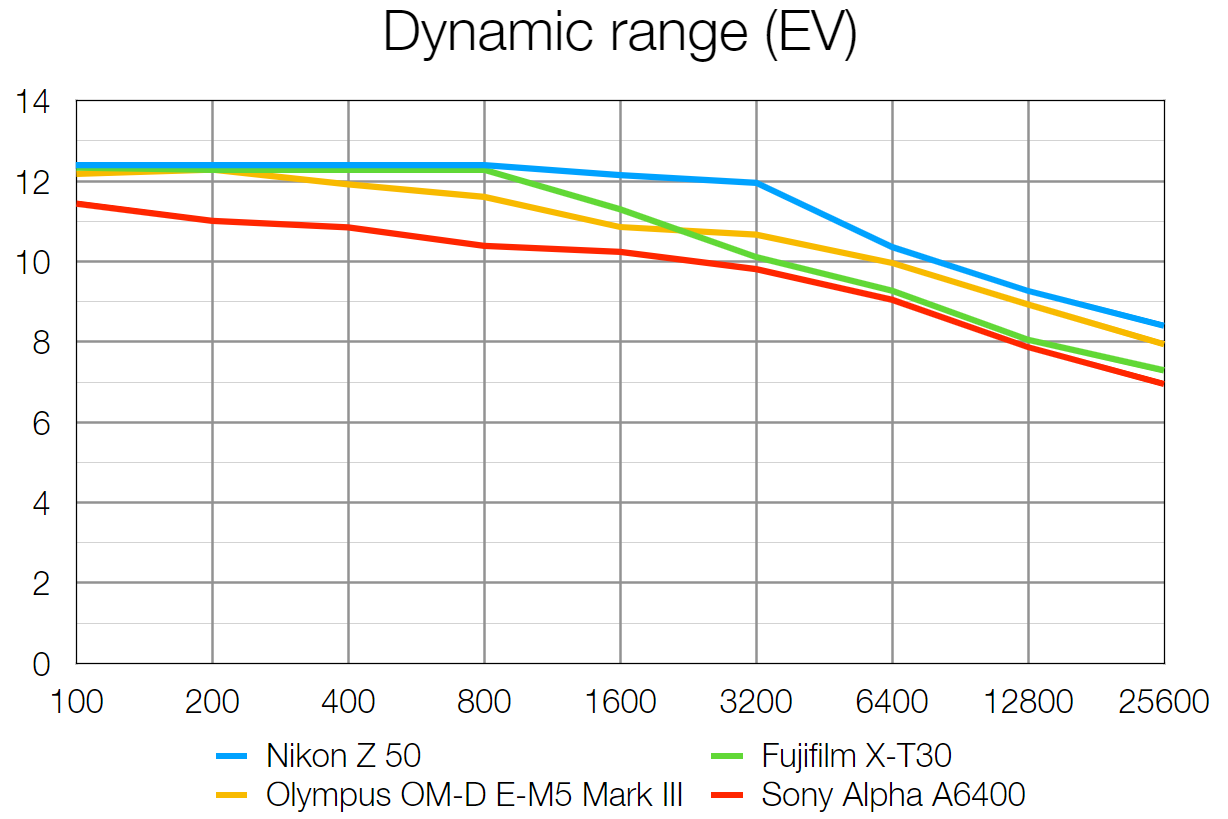
The Z 50 scores very well for dynamic range, even outperforming the mighty Fujifilm X-T30 and its excellent X-Trans 4 sensor. The X 50's superiority is most evident at higher ISOs, where it holds a clear lead over all its key rivals.
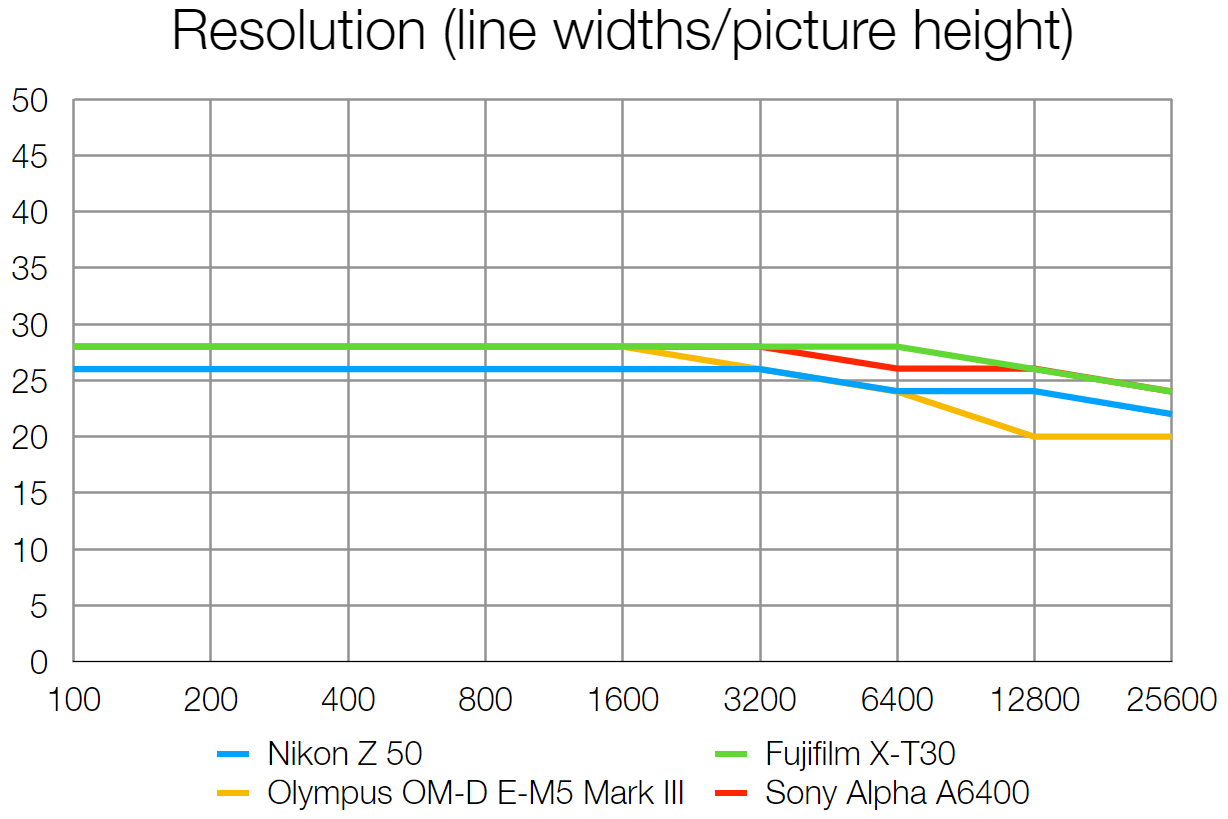
The only area of our lab tests where the Z 50 doesn't excel is resolution. It's 20.9MP raw images (after conversion to uncompressed TIFF) don't quite contain the sharpness and fine detail you get in the 24MP images from the Fujifilm X-T30 and Sony A6400. Unsurprisingly, the Z 50 is on par with the 20.4MP Olympus E-M5 Mark III.
Nikon Z50: Verdict

Technically, the Z 50 might sound like a scaled down version of the Nikon Z6 II and Z7 II, but in the flesh it has a very different feel. Nikon has done a remarkable job of giving such a small camera such a solid one-handed grip, but quite apart from the size of the camera, we were impressed by the 16-50mm pancake kit lens which is one of the slimmest APS-C kit lenses we've yet seen and uses a 'proper' mechanical zoom rather than an electrical power zoom system – these always feel rather 'disconnected'.
But there are still three things to think about: one is that the Nikon Z5 isn't THAT much bigger or more expensive, another is the relative lack of DX lenses for the Z50 right now, and the third is that the Nikon Z fc has just been announced, with a beautiful retro design that does leave the Z50 looking distinctly plain.
• The best Nikon Z lenses for the Z6, Z7 & Z50

Even so, we are impressed by Nikon's pricing. Body only, the Z 50 costs less than some of its chief APS-C rivals, and the pricing for the kit lens and twin lens bundles is really quite remarkable.
We were happy with the image and video quality produced by the Nikon Z50, and genuinely enjoyed zipping around the back streets of Bath capturing quick snapshots with this dinky little camera. Overall, we think this is a fantastic enthusiast mirrorless camera (at an even more fantastic price), and proves that Nikon has a clear vision for its Z-mount cameras. We can't wait to see what it pulls out of its bag of tricks next.
Read more
• Nikon mirrorless cameras and lenses
• Nikon camera rumors
• The best Nikon cameras
• These are the best mirrorless cameras
• DSLR vs mirrorless cameras: we explain the differences
• Nikon Z7 full review
• Nikon Z6 full review
• Nikon Nikkor Z 24-30mm f/4 S review
• Nikon Nikkor Z 24-70mm f/4 S review
• Nikon Nikkor Z 35mm f/1.8 S review
• Nikon Nikkor Z 50mm f/1.8 S review
• Nikon Z50 vs D7500
N-Photo: The Nikon Magazine is a monthly magazine that's written by Nikon enthusiasts for Nikon enthusiasts, so you can be sure that all the content is 100% relevant to you! So for the best Nikon-focused news, reviews, projects and a whole lot more, subscribe to N-Photo today – with our unmissable sub deal!
With over a decade of photographic experience, Louise arms Digital Camera World with a wealth of knowledge on photographic technique and know-how – something at which she is so adept that she's delivered workshops for the likes of ITV and Sue Ryder. Louise also brings years of experience as both a web and print journalist, having served as features editor for Practical Photography magazine and contributing photography tutorials and camera analysis to titles including Digital Camera Magazine and Digital Photographer. Louise currently shoots with the Fujifilm X-T200 and the Nikon D800, capturing self-portraits and still life images, and is DCW's ecommerce editor, meaning that she knows good camera, lens and laptop deals when she sees them.

